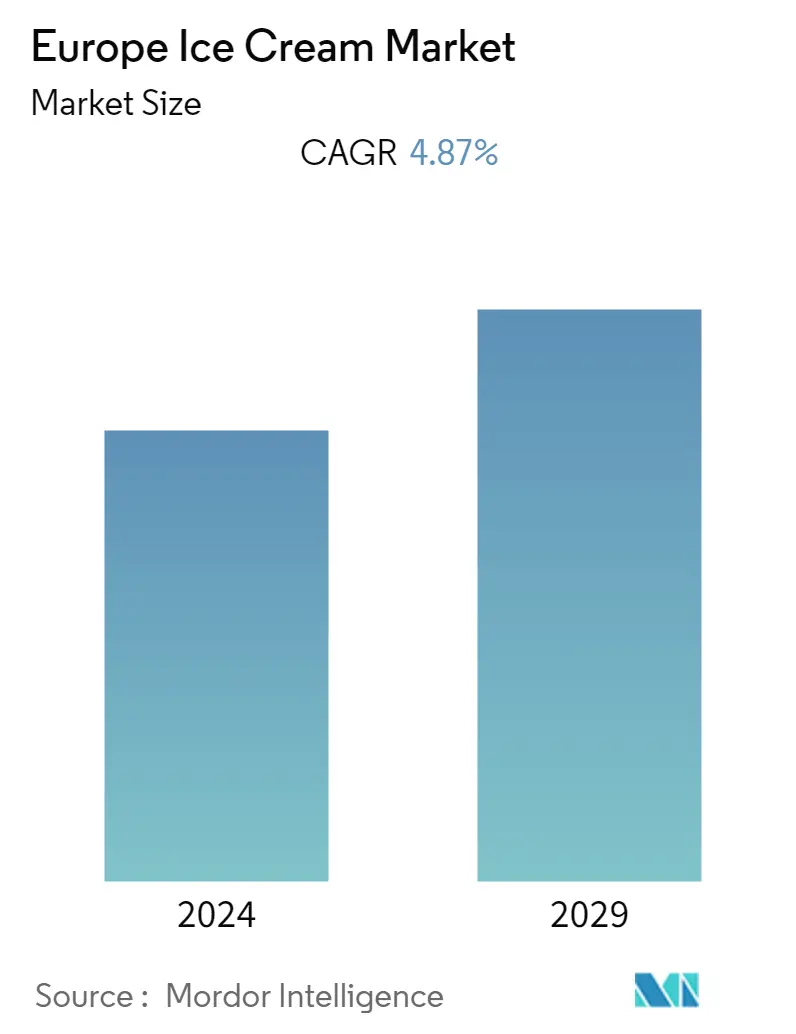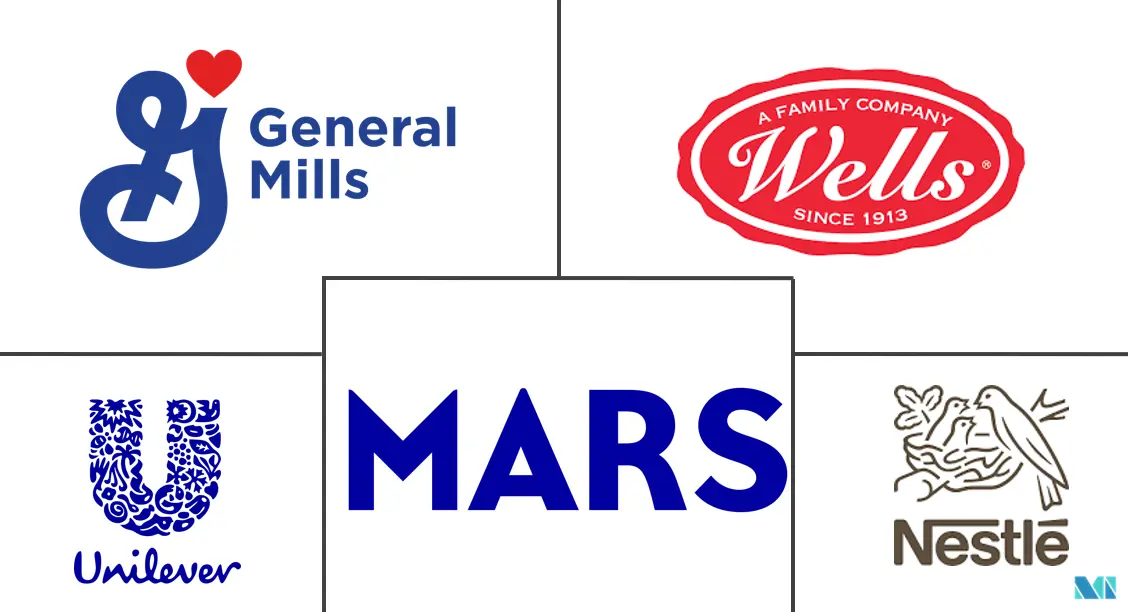Market Size of Europe Ice Cream Industry

| Study Period | 2019 - 2029 |
| Base Year For Estimation | 2023 |
| Forecast Data Period | 2024 - 2029 |
| Historical Data Period | 2019 - 2022 |
| CAGR | 4.87 % |
| Market Concentration | Low |
Major Players
*Disclaimer: Major Players sorted in no particular order |
Europe Ice Cream Market Analysis
The European ice cream market is projected to record a CAGR of 4.87% over the upcoming five years.
Demand for ice creams that are low on fats, made using natural ingredients, yet do not compromise on taste and indulgence is growing across Europe. Germany and Russia are the biggest ice cream markets in Europe. Over the medium term, indulgence and the increasing consumer preference for ice cream as a leisure product drove the growth of this market, and new innovative flavors, offered by companies, further act as a catalyst for demand generation.
One of the popular trends in the European ice cream market is the premiumization of ice creams. Europeans prefer premium ice creams due to their distinctive flavors and portions. Premium ice cream has a higher percentage of butterfat and fewer air particles per ice cream particle. The demand for luxury ice cream and regular ice cream desserts is also rising sharply in the European market due to the continent's rapidly expanding urbanization and the dairy industry's improved technological improvements. The key causes driving the increase in the European ice cream market's annual sales are the use of novel ingredients such as whole milk, skim milk, and sweetening and flavoring agents.
Additionally, there has been an ongoing trend of artisanal ice cream across European regions like Italy, France, and others regions. The key players in the market are expanding their reach to different countries in the region. In September 2021, Barilla, an Italian food company, collaborated with Algida, a Unilever brand, to cater to the Italian customer base with a new range of ice creams.
Europe Ice Cream Industry Segmentation
Ice cream is a sweetened frozen food typically eaten as a snack or dessert. The European ice cream market is segmented by product type, category, distribution channel, and geography. By product type, the market is segmented into artisanal ice cream, impulse ice cream, and take-home ice cream. By category, the market is segmented into dairy and non-dairy. By distribution channel, the market is segmented into on-trade and off-trade. Off-trade is further sub-segmented into specialist retailers, hypermarkets/supermarkets, convenience stores, online retail stores, and other distribution channels. By geography, the market is segmented into Germany, the United Kingdom, France, Russia, Spain, Italy, and Rest of Europe. For each segment, the market sizing and forecasts have been done on the basis of value (in USD million).
| Product Type | |
| Artisanal Ice Cream | |
| Impulse Ice Cream | |
| Take-home Ice Cream |
| Category | |
| Dairy | |
| Non-dairy |
| Distribution Channel | |||||||
| On-trade | |||||||
|
| Geography | |
| Germany | |
| United Kingdom | |
| France | |
| Russia | |
| Spain | |
| Italy | |
| Rest of Europe |
Europe Ice Cream Market Size Summary
The European ice cream market is experiencing a notable growth trajectory, driven by evolving consumer preferences and innovative product offerings. The demand for ice creams that balance indulgence with health-conscious attributes, such as low-fat and natural ingredients, is on the rise. This trend is particularly evident in major markets like Germany and Russia, where ice cream is increasingly viewed as a leisure product. The market is also witnessing a shift towards premiumization, with consumers favoring ice creams that offer distinctive flavors and higher quality. The artisanal ice cream segment, especially gelato, is gaining popularity, with companies like Unilever and Nestlé expanding their offerings to cater to this demand. The use of novel ingredients and technological advancements in the dairy industry are further propelling market growth.
In response to growing health consciousness and lifestyle diseases, there is a rising demand for dairy-free and vegan ice cream options across Europe. This shift is encouraging companies to innovate and expand their product lines, as seen with brands like Ben & Jerry's and LUB Foods. The market is also benefiting from increased online presence and e-commerce collaborations by major players, enhancing brand visibility and consumer reach. The introduction of new flavors and product variants, such as Unilever's vegan range and Häagen-Dazs' multi-textured ice creams, reflects the industry's adaptability to consumer trends. Overall, the European ice cream market is poised for continued expansion, supported by diverse product offerings and strategic market initiatives.
Europe Ice Cream Market Size - Table of Contents
-
1. MARKET DYNAMICS
-
1.1 Market Drivers
-
1.2 Market Restraints
-
1.3 Porter's Five Forces Analysis
-
1.3.1 Threat of New Entrants
-
1.3.2 Bargaining Power of Buyers/Consumers
-
1.3.3 Bargaining Power of Suppliers
-
1.3.4 Threat of Substitute Products
-
1.3.5 Intensity of Competitive Rivalry
-
-
-
2. MARKET SEGMENTATION
-
2.1 Product Type
-
2.1.1 Artisanal Ice Cream
-
2.1.2 Impulse Ice Cream
-
2.1.3 Take-home Ice Cream
-
-
2.2 Category
-
2.2.1 Dairy
-
2.2.2 Non-dairy
-
-
2.3 Distribution Channel
-
2.3.1 On-trade
-
2.3.2 Off-trade
-
2.3.2.1 Specialist Retailers
-
2.3.2.2 Hypermarkets/Supermarkets
-
2.3.2.3 Convenience Stores
-
2.3.2.4 Online Retail Stores
-
2.3.2.5 Other Distribution Channels
-
-
-
2.4 Geography
-
2.4.1 Germany
-
2.4.2 United Kingdom
-
2.4.3 France
-
2.4.4 Russia
-
2.4.5 Spain
-
2.4.6 Italy
-
2.4.7 Rest of Europe
-
-
Europe Ice Cream Market Size FAQs
What is the current Europe Ice Cream Market size?
The Europe Ice Cream Market is projected to register a CAGR of 4.87% during the forecast period (2024-2029)
Who are the key players in Europe Ice Cream Market?
Unilever PLC, Nestlé S.A., Mars, Incorporated, Wells Enterprises, Inc. (Halo Top) and General Mills, Inc. are the major companies operating in the Europe Ice Cream Market.

